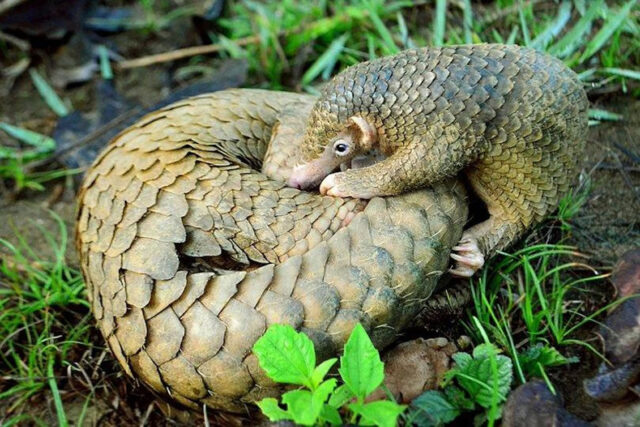As China spreads its backwards culture into Africa, the market for African versions of traditional Chinese medicines has exploded. With that has come the mass killing of native African species for their body parts.
Traditional Chinese Medicine (TCM) is an odd part of the Chinese economic invasion of the world. It brings with it beliefs in medical treatments which originated in some cases millennia ago, long before understanding even of basic anatomy and how to treat illnesses even of the simplest kinds were well understood. While there are some aspects to it that are valid and highly useful, there are also aspects that are based on erroneous beliefs and are highly destructive.
In Africa, relying on traditional medicines created by their own ancestors is a fundamental part of the culture of some nations. They are also made from a variety of animal parts to gain their supposed medicinal power, just as TCM are.
So, it is an easy sell to bring TCM into the continent, as well as to market it in a similar way, arguing for the long-term historical relevance of old knowledge, even if what the Chinese are peddling in these medicines has no real healing power.
Bringing in the medicines also involves, for the companies China is establishing on the continent to make and sell them, locally sourcing ingredients like those in the traditional medicines fabricated in Asia. As it turns out, these “authentic” reconstructions of CTMs – now being sold to yet another massive potential market of the uneducated in Africa – serve also to include many unproven ingredients which are either toxic, include parts from endangered species, or both. By doing so, they are endangering the lives of those species on an even broader scale than ever before while also putting the lives of those who take the medicine at risk.
That is the conclusion of Lethal Remedy, a just published report by the United Kingdom-based Environmental Investigation Agency (EIA).
The spread of Chinese Traditional Medicine manufacture, use, and sale is embedded in China’s global Belt and Road business initiative, a strategic venture under which China is attempting to integrated much of the global business market within just a few days’ shipping time of the PRC (People’s Republic of China).
As the report notes, “Major TCM companies and countless clinics of already been established across Africa, with further plans to construct full supply chains for sourcing to sales.”
The invasion of Africa which this involves has been managed carefully on multiple levels, including:
- Signing official agreements between African nations and the PRC to develop TCM products and sales.
- Working to get individual countries to pass local laws endorsing the making and use of TCM products in the countries there. Namibia and South Africa are noted as key examples.
- Taking advantage of the pandemic panic among the peoples of Africa to create an effective marketing campaign for these non-medicines as something to take while potentially dying of the coronavirus. These campaigns also include treatments to be taken despite having no evidence of the presence of the coronavirus.
In terms of statistics, currently it is known that some 21,000 medical professionals and at least 2,000 people now claiming to be trained practitioners of TCM are present on the continent. 45 countries provide the bases of operation for these people, in countries such as Cameroon, Malawi, Tanzania, Uganda, Zambia, and Zimbabwe.
These have been established over decades in some locations, with a boom period in recent years. It is part of China’s explicit marketing plan for the region.
Though the so-called medicines have mostly no ability to ease pain, slow the spread of disease, or cure anything, the poor and uneducated are an easy target for the Chinese marketing assault which has made TCM sales so successful.
According to the EIA report, the TCM makers have pulled multiple pages out of their use of ingredients such as body parts and bodily fluids from species ranging from Chinese tigers to the Asian pangolin, transplanting them into the local market by replacing them with similar elements from lions and the scales of the African variant of the pangolin.
Common to both traditional African medicine (TAfM) and TCM are parts of species such as the rhino, hedgehog, tortoise, and pangolin.
The elephant, in its Asian form at least, may not be listed among the ingredients lists in the global Pharmacopeia, but the EIA notes that there are at least four registered patent medicines which use elephant ivory as shavings or powder, to treat everything from sore throats, seizures, and boils. Elephant skin is also used by traditional Chinese medical practitioners to help heal routine wounds, ulcers, and even hemorrhoids. Some of the Chinese manufacturers even source these parts all the way from endangered African elephants, in the form of ivory, elephant skin, and hair. That is also all happening legally – except for the ivory – as written into the Convention on International Trade in Endangered Species (CITES), with Botswana, Namibia, South Africa, and Zimbabwe all noted as legally authorized to export such materials.
For the TCM makers setting up shop in Africa, direct access to those elephant parts plus availability of ingredients from the other common parts, whether endangered or not, makes the African market appealing as a new source of mass exploitation of animals even if it pushes many of them close to extinction in the process.
Among other creatures being taken in the wild and sometimes bred just for body parts and bodily fluids for the African form of TCMs are seahorses, the tokay gecko, leopards, African rhinos (for their horn), saiga (for their horn), local endangered versions of tortoise, hedgehog, and porcupine.
For African nations which are in dire need of hard currency, inviting the Chinese in to take advantage of their people and to make and sell products which can kill off animals while posing a genuine danger to those taking the medicines is taken by many countries as a fair exchange, despite the damage it does to all. South Africa and Namibia, just as two examples, have gone so far as to formally recognize traditional Chinese medicines as legitimate treatments within those countries’ treatment protocols. Other countries, such as South Africa, have now legalized captive breeding of wild large cat species such as lions or leopards, for the purpose of harvesting their parts for TCMs.
In South Africa, a November 2019 memorandum from the Northern Cape government uncovered by the Environmental Investigation Agency authorizes the sale of Rhino horn “in order to expedite the process of legalizing commercialization …for medicinal purposes.”
Besides the obvious evils of potentially wiping out endangered species, marketing useless medicines made of those species, and encouraging the public to take these medicines at a high risk to themselves, there is yet another reason the EIA warns that theses medicines should be blocked from manufacture and banned for sale. That is the potential risk of spreading zoonotic diseases, illnesses such as the coronavirus which likely was derived from similar viruses found in Chinese bats and crossed species to infect humans, broadly across Africa.
None of this will stop without the African governments themselves stepping up and demanding the end of foisting these dangerous and exploitative concoctions known as traditional Chinese medicines on the people. With those governments more than happy to be bribed with money and more from Beijing to allow this to happen, no one should count on those governments doing anything about this anytime soon.
With total sales of traditional Chinese medicine in 2021 estimated to hit 75.3 billion Chinese yuan (US $11.81 billion) by the end of 2021, with an estimated annual compound sales growth rate of about 5 percent just in China’s core home market, and with high gross margins, no one should look to the PRC to do anything on their end to stop this abuse of nature and the public who happily consume these fake medicines.
One of the factors that is allowing TCM to flourish in Africa is the predatory nature and failure of western medicine and its forced vaccination program. Many Africans simply don’t trust western medicine or the evil billionaires behind it. At the same time, practitioners skilled in TCM can often more accurately diagnose ailments, even if they can’t prescribe an effective treatment.








